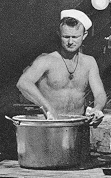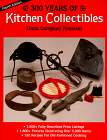
Four Navy Cooks Prepare a Meal Somewhere in the Pacific
By Steve Karoly
 A picture, as
they say, tells a thousand words -- if you know what
you're talking about.
A picture, as
they say, tells a thousand words -- if you know what
you're talking about.
Click on the picture at the right and view the Navy photograph from World War II. If you know what you're looking for, it tells quite a story. This picture gives you a good look at World War II era field feeding equipment.
The baker is mixing cake batter. Of the four cakes cooling on the makeshift serving line, two are lopsided. Baking cakes in a M1937 field range was tricky. The baker had to turn each cake three times to ensure even baking. Often the cakes came out lopsided despite the extra care.
The second cook from the left is removing roast beef from the first field range. Cooks used the large, square pan, called a squarehead, for baking and roasting. The cook placed the squarehead on the top shelf of the field range and placed a lid over the pan. This set up worked much like a cast iron Dutch oven.
Two different sized pots are seen in the photograph. The baker is using a 10 gallon pot (called an insert in the M1937 field range technical manual). A 15 gallon pot is sitting on the ground to the right of the cook . The 10 gallon pots would nest inside the larger pot to form a double boiler.
The cooks used the pots for a multitude of uses: they cooked sauces, vegetables and casseroles in them; used them to mix batters; and used them as serving pans.
When you see pictures of field chow lines, you'll see a mixture of pots and pans. The cooks would serve the soup out of a 15 gallon pot, the vegetable and starch from 10 gallon pots and the main entree from a squarehead (a large aluminum pan--it's not pictured here). Salads would be served from any available pot or pan while cakes, rolls and bread would be served from the flat sheet pans.
The objects sitting on the deck behind the center tent pole are pot cradles. It was used to steady the pot when it was placed inside the field range. It looks like the spare pots and pans were being stored behind and to the right of the fourth cook.
This photograph shows at least three field ranges. There may be a fourth range located directly behind the second cook. With three ranges, this mess could support 225 sailors. Add a fourth ranges and it could have fed 300 sailors. Each field range was equipped with all the pots, pans and utensils needed to cook a meal in the field. A fire unit was added as the heat source for the range.
Tent lights are a Seabee trademark. These cooks didn't have to worry about priming and lighting Coleman lanterns. You don't see much evidence that blackout regulations were being followed. It's possible that this galley is at a back water base where there was little possibility of a Japanese attack. Since the cooks started breakfast at about 0300, they may have simply dropped the tent flaps to minimize light from reveling the bases' position.
Note the lack of concern for sanitation regulations. All of the cooks except one wear hats--the second cook even wears chef's cap! But they've violated a cardinal Navy rule: only one is wearing a shirt. Maybe the sailor withiout a hat is just visiting the galley.
August 1999
| Bulletin Board | Keyword Search |
| Bookstore | Links |
| About Us | Recent Additions |
![]()

